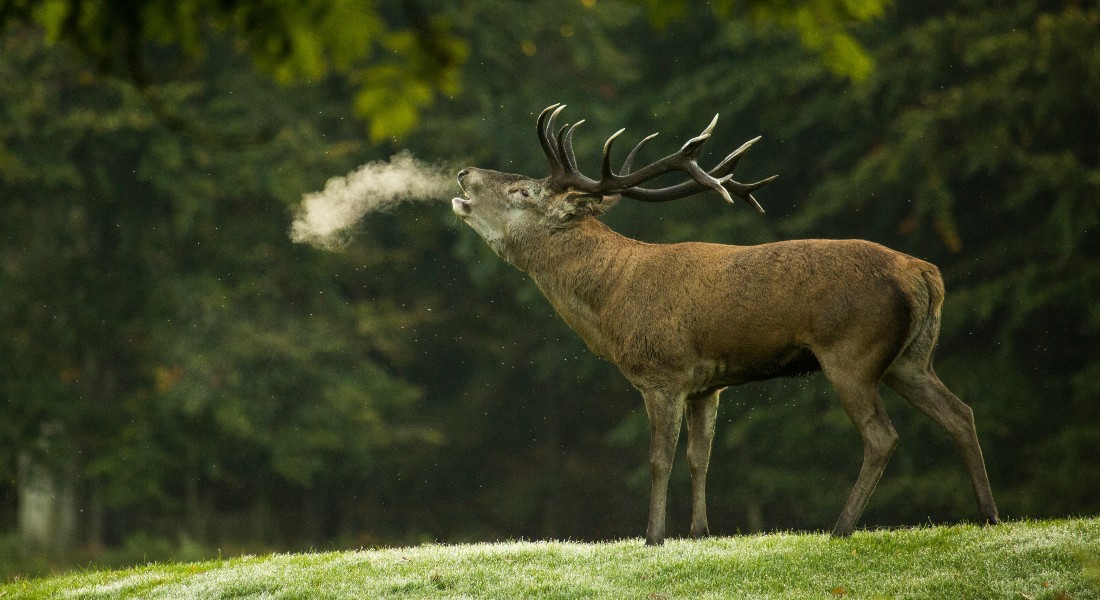A new nationwide survey from the University of Copenhagen shows that most Danes would like to see more large animals in the forests. Danes prefer forests with wild animals such as red deer and bison to traditional nature conservation with cattle and sheep. However, a significant minority are far from enthusiastic about nature with fences and large animals.

Most Danes would like to visit forests with large wild animals - even if this means fences and restrictions in access. This is shown by a new survey of almost 2,900 Danes conducted by the Department of Food and Resource Economics at the University of Copenhagen.
The researchers investigated how different animals and types of fencing affect the interest to visit the forest. The results show that over 60 per cent of participants prefer forests with large animals to forests without.
"The most surprising thing is how much support there is for certain animals such as red deer and bison. This tells us that many Danes actually want more "wild" nature. Even among people who are against rewilding, animals such as red deer or moose seem to be preferred over cattle," says lead author Tim de Kruiff.
Red deer were clearly the most popular species, closely followed by moose and bison, while traditional grazers such as sheep and cattle were less appreciated, especially among those who value the nature experience highly. In fact, the study shows that Danes are willing to drive up to 36 kilometres extra to visit forests with red deer, even if the forest is fenced.
One in ten do not want fences and cattle
Although many support more wild nature - or so-called "rewilding" - there is clear resistance among a small but significant group. 11 per cent of participants did not want to visit forests with large grazers and fences.
According to the researchers, this is due to animal welfare concerns, but also the fear of encountering large animals such as cattle during their walk. This group consisted mainly of older people and people living outside the big cities.
"We see a clear polarisation. Some love the idea of wilder forests, while others are directly repelled by it," explains Tim de Kruiff.
At the same time, the study shows that access with a dog is crucial for a large group. For 15 per cent of participants, the possibility of bringing their dog was the most important factor in choosing a forest.
None of the identified groups object in general to dogs on a leash - which, according to the researchers, makes it an obvious way to increase satisfaction across the board.
"Allowing dogs on a leash can actually be a win-win for everyone - without necessarily harming wildlife," says co-author and professor Jette Bredahl Jacobsen.
Important knowledge for future national parks
The study comes in the midst of the political debate about the 15 planned national parks in Denmark. Here, large grazers such as red deer and cattle will contribute to biodiversity, but the plans have met with resistance from both citizens and experts.
According to the researchers, the results of the study can provide important input for the design of the parks.
"The choice of animals matters. If you want broad support, you should prioritise species such as red deer and moose over cattle," says Jette Bredahl Jacobsen.
According to Tim de Kruiff, another important point is that consideration should be given to how the opportunities to visit the forest can be designed to accommodate as many people as possible.
"For example, being able to enter and exit the forest through the fence in different places, so that you have flexibility in the trips you can choose, is very important," he says.
The researchers emphasize that there is no one-size-fits-all solution. Some people are opposed to rewilding. However, by thinking about the design of a forest with large grazers, it is possible to reduce resistance from sceptics.
About the study
The study in brief: Rewilding and forest recreational value: A choice experiment analysis of the impact of large herbivores and fences in nature management - ScienceDirect
- A new study from the University of Copenhagen involving 2,900 Danes shows strong support for wild animals in the forest.
- Red deer and bison score highest, while sheep and cattle are least popular.
- 11% do not want to visit forests with large grazers and fences at all.
- Access roads and dog permits are crucial for satisfaction.
- The results can be used to design more inclusive nature national parks.
CRediT authorship contribution statement
Tim de Kruiff: Writing - original draft, Visualization, Methodology, Formal analysis, Data curation, Conceptualization. Thomas Lundhede: Writing - review & editing, Methodology, Conceptualization. Frank Søndergaard Jensen: Writing - review & editing, Funding acquisition, Conceptualization. Christian Gamborg: Writing - review & editing, Conceptualization. Jette Bredahl Jacobsen: Writing - review & editing, Methodology, Conceptualization.
Declaration of generative AI and AI-assisted technologies in the writing process
During the preparation of this work the author(s) used Microsoft Copilot in order to improve text for readability and conciseness. After using this tool/service, the author(s) reviewed and edited the content as needed and take(s) full responsibility for the content of the publication.
Declaration of competing interest
The authors declare that they have no known competing financial interests or personal relationships that could have appeared to influence the work reported in this paper.
Acknowledgements
The authors gratefully acknowledge Anders Busse Nielsen and Marie Alstrup Jensen for their drawings of forests, fences and animals for use in the survey. We also gratefully acknowledge the comments from two anonymous reviewers, whose comments greatly benefitted this article.
Funding
This research was supported by funding from the Danish Ministry of Environment, but mainly funded by the University of Copenhagen.






